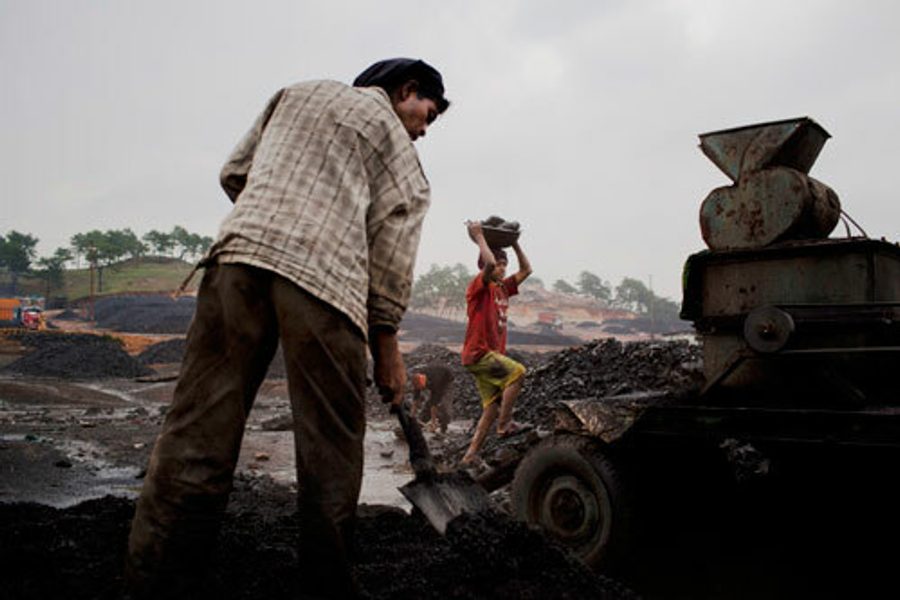
Decades after it was identified as a widespread and fatal occupational health risk, black lung disease among coal miners is on the rise, according to government statistics and a chilling examination of the bodies of the 29 miners killed in the Upper Big Branch coal mine disaster in West Virginia last April.
Almost three quarters of them had black lung disease, including young miners, autopsies showed — despite government regulations meant to reduce exposure to coal dust and a government compensation program for miners who suffer black lung and their widows. That is much higher than the average among active American coal miners. (See Roger Bybee’s piece today on a new report finding Massey Energy at fault for the tragedy.) Reuters reported:
Data from the National Institute for Occupational Safety and Health (NIOSH) show the incidence of black lung cases declined following the 1977 Coal Mine Safety and Health Act through the early 1990s, but this decline stopped in the 1995-99 period, and the incidence has risen since then.
Among active coal miners with more than 30 years of underground mining, the prevalence of CWP declined from 35 percent in the early 1970s to about 7 percent in the late 1990s. However, it increased to nearly 10 percent in the mid-2000’s, the NIOSH figures show.
Pennsylvania accounted for more than half the cases of black lung in the past 15 years, while Virginia, West Virginia and Kentucky also had high rates.
In India and China, meanwhile, where coal is the bedrock of exponential industrial and economic growth, black lung is just one of the dangers facing coal miners that include thousands of teens and even children. As The Los Angeles Times reported in a poignant story and photo essay recently, Indian coal is harvested and processed largely by minors, whose small bodies are well-suited for narrow coal seams.
Indian youth have seen their horizons expand greatly in the past generation, as the country’s exploding economy has opened up new educational and occupational opportunities. But youth from poor rural areas and immigrant youth from less-developed nearby countries including Nepal and Bangladesh don’t even dare dream of going to school, seeing their futures occupied only with “cutting coal.”
In the United States, mining has been largely automated as a way to increase efficiency and cut costs. But in rural India people including migrants and children are so desperate for work that companies employ them for almost nothing rather than investing in automation. The L.A. Times says:
The young miners descend on rickety ladders into the makeshift coal mines dotting the Jaintia Hills in northeast India, scrambling sideways into ‘rat hole’ shafts so small that even kneeling becomes impossible. Lying horizontally, they hack away with picks and their bare hands: Human labor here is far cheaper than machines.
The Times notes that India reported 81 coal mine deaths in 2009, but the true number is likely much higher as deaths are covered up. Some miners pay for funerals, others pay nothing, the Times says. The young workers labor in flip flops and T-shirts without safety equipment, and there is little medical care available.
The nearest medical dispensary, selling little more than aspirin, acne soap and herbal remedies, is a few miles away.
Child labor in mines is not limited to India and China or to coal, but is reportedly common across Asia, Latin America and Africa. The film The Devil’s Miner chronicles the lives of young tin miners in Bolivia.
At the Empire Mine state park in northern California during my recent visit, visitors gasped at the photos and descriptions of gold mining from the mid-1800s to mid-1900s.
Miners, including many teenage boys, would climb into rickety carts each morning for a rapid descent – 600 feet per minute — into the gaping shaft. Then they would work up to 8,000 feet below the earth, wearing gas lights on their helmets and using sharpened steel spears and later pneumatic drills to make holes packed with gun powder. Blasting would create clouds of rock dust that gave countless miners deadly cases of the lung disease silicosis. Water or deadly gases could fill up the tunnels at any moment.
Dangerous and unhealthy as mining in the United States may still be, things have changed a lot in the last century. But the metals for consumer goods we buy in the United States, and the coal used to generate electricity to create these goods, are often mined in conditions just as shocking or even moreso than the Wild West days of the gold rush.
Kari Lydersen is a Chicago-based journalist, author and assistant professor at Northwestern University, where she leads the investigative specialization at the Medill School of Journalism, Media, Integrated Marketing Communications. Her books include Mayor 1%: Rahm Emanuel and the Rise of Chicago’s 99%.








